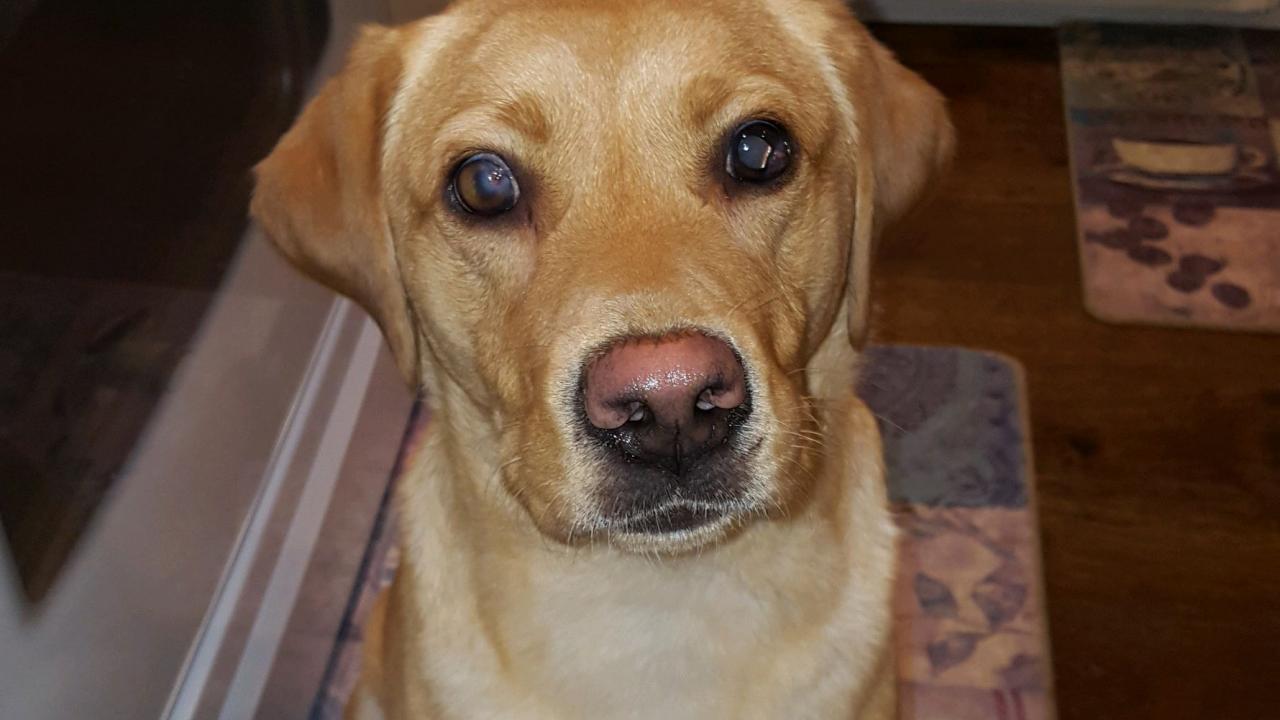
UC Davis Ophthalmologists Save Dog’s Eyes Following Accident
“Case of the Month” – April 2019
Rally, a 1-year-old female Labrador retriever, was accidentally shot while on a hunting excursion, with both of her eyes sustaining major trauma. Her owners immediately rushed her to a local emergency clinic that then referred her to the Ophthalmology Service at the UC Davis veterinary hospital. With seven board-certified ophthalmologists, four ophthalmology residents, one ophthalmology intern, and 24-hour emergency availability, UC Davis was the right place for Rally’s care.
Upon arrival, examination revealed that Rally did not have vision in either eye as she did not respond to bright light shone into either eye. She had penetrating wounds to both corneas with iris tissue protruding through the wounds. The front chambers of her eyes had blood and inflammation within them, which prevented veterinarians from thoroughly assessing the deeper structures in either eye.
To further assess the damage, the hospital’s Diagnostic Imaging Service performed a CT scan, which showed 14 pieces of shot distributed throughout her right ear, muzzle, both orbits, and the muscles of her head. Assessment of the eyes revealed that shot had passed through both corneas and out of the eyes, and the pellets were sitting adjacent to her eyes but not within the eyes themselves. Thankfully, no pellets entered her brain. With this imaging to better form their surgical plan, faculty member Dr. Steve Hollingsworth and resident Dr. Kelly Knickelbein performed emergency surgery to repair Rally’s eyes.
Before the procedure, it was apparent that Rally’s right eye sustained the most damage. There was little hope to restore vision to that eye, but ophthalmologists were hopeful to at least save the eye for cosmetic purposes, so long as it was not a persistent source of pain. However, there was a slim but possible chance for Rally to regain vision in the left eye if the surgery and recovery went well.
During surgery, conjunctival flaps were placed in both eyes to stabilize the corneal wounds. Three shot pellets were removed from Rally’s right ear. Due to severe swelling of the right ear and muzzle and the depth of the other pellets, the decision was made to leave the remaining non-toxic pellets in place.
Rally recovered well from anesthesia and was released from UC Davis two days after surgery. At the time of discharge, her eyes were healing appropriately, but she had not regained vision in either eye. Veterinarians were cautiously optimistic that it was still possible Rally may regain some vision as the inflammation subsided, though it was likely that she would be permanently blind. While they repaired the corneal wounds in both eyes, each eye also had an exit wound that could not be repaired. Future potential complications for Rally included persistent intraocular inflammation, glaucoma, shrinkage of her eyes, and the need to remove one or both eyes.
Rally’s owners diligently began her home care of numerous eye drops, eye ointments, and several oral medications multiple times per day. At her one-week recheck appointment, she still had no vision in either eye, however Rally made a remarkable recovery by her three-week recheck appointment – ophthalmologists saw indications of vision from her left eye!
Rally was examined several more times over the next few months. Now four months after the accident, Rally’s right eye remains blind but comfortable, and Rally continues to have vision from her left eye.
# # #
The School of Veterinary Medicine's efforts to build a new Veterinary Medical Center are underway. A larger hospital will allow the school to provide clinical experience for veterinary students and veterinary specialists in a more efficient and effective manner. More life-changing surgeries like Rally's will be possible with an increased caseload, more advanced equipment and surgical suites, and clinical trials research translating to cutting-edge care. Please consider joining us on that journey.
